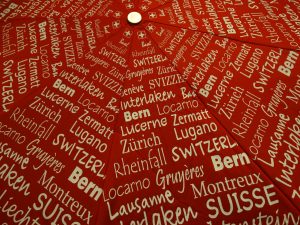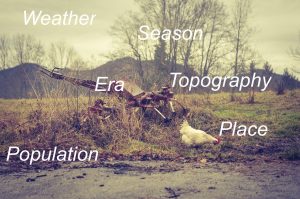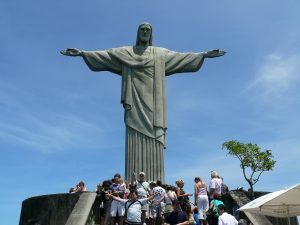What’s Included in Setting?
A story setting is more than the place(s) where the author sets characters. It provides the environment in which your drama unfolds, so establish it early in your story. It’s interactive—creating the mood, giving meaning to the plot, and strengthening the story theme.
 Elements Under the Setting Umbrella
Elements Under the Setting Umbrella
- Locale (state, neighborhood, island, saw mill, school)
- Weather (tornados, tsunamis, snow, fog, sand storms)
- Atmosphere (lighting, humidity, clutter, noise, crowding)
- Props (candle, perfume, bowie knife, vacuum cleaner, harpoon)
- Era (Civil War, Information Age, Roaring Twenties, Ancient Greece, Civil Rights Movement)
- Time (1942, summer, dawn, Christmas, Independence day, February)
- Culture (social practices, laws, fads, morals & mores, politics)
- Geography (mountains, plains, marshes, islands, deserts)
- Plant and animal life (whales, palms, rice paddies, grizzly bears, kangaroos)
- Population (dense NYC/Hong Kong; small town; deserted island, Indian reservation; military camp)
- Manmade entities (ports, burial grounds, cities, museums, pyramids)
- Agriculture (vineyard, ranches, plantations, soil, minerals)
- Ancestral heritage (unique groups, cuisine, dialect, attitudes, religions)
- Climate influences (ocean currents, notable winds, latitude, altitude, tropics)
- Fantasy/Sci-fi (portals, magical/Sci-fi phenomena, future era, topography, climate)
Tips to Write a Setting
1. For authenticity, characters must interact with the things surrounding them. The things characters interact with should be meaningful to the story.
2. Setting can be woven into the story through:
- known landmarks (Statue of Liberty, Eiffel Tower, Alamo)
- communication devices of the period (smoke signals, black desk telephones, tablets)
- items characters use (laser gun, plow & mule, data cards)
- clothing (gingham dress, polyester bikini, sari)
- music (minuet, country, reggae),
- popular sayings (swell, groovy, ballistic)
- rooms (lanai, parlor, veranda)
- types of buildings (shack, palace, cottage)
- events (bubonic plague, gold rush, D-day)
- jobs (chimney sweep, backhoe operator, financial planner)
3. What level of setting details is needed?
- At one end, familiar settings may need only a few details for a reader to understand the characters’ environment.
- At the other end, created worlds and settings that are considered a character may need intricate and abundant details (a haunted house as a character).
- Once the reader understands the setting, detailing elements may seem repetitive, especially for faster paced stories. Occasional references or, more often, using the characters’ interactions with setting elements may be more appropriate.
4. View the location as if you’re employing a movie camera.
- First, decide the locations, and the places within locations, that best support your plot, characters, and story mood.
- Then view the place through your camera lens. This will force you to consider all facets of the place so that you supply, or make more vivid, the features the reader needs in grasping the setting.
5. Mention notable items that readers familiar with the area expect to appear in the setting.
In Part 2, we’ll look at fictional vs. real settings.
Story setting is more than a place; consider this list of the elements. Click to tweet.
What tip do you have to ensure readers understand the story’s setting?





 RSS - Posts
RSS - Posts



I do neglect the setting. So, after writing, I always have to go back and put that in. Thanks for the reminder.
Hi Katheryn. I try to pay attention to my characters’ surroundings as I write, but I definitely need to take my video camera and employ it on every scene in the rewrite stage.
Hi Zoe, great post. I love it when authors weave details on setting into the story, rather than long patches of description. And it’s kinda lazy when setting is described while a character is “watching” or ” looking.” At least let them be on horseback or a hike or something LOL. One thing, too, is accuracy. I have read two romances recently that drew me because of the setting. Neither book sounded as if the author knew anything about the setting. Come on. With the internet and GoogleEarth, it’s not hard to find images of where you are. Of course it’s best if the author can actually be there, but sometimes not possible. Enjoyed this so much. xo
Hi Tanya. Thanks for adding what you’ve encountered. Just writing this post put the fear in me to do a good job on my research. I’m glad you mentioned searching the Internet. It’s amazing what’s out there. Of course, occasionally I can’t find what I need. But if I ask on large writer groups, usually I receive my answer.
I love researching the setting, and often come up with plot lines in that process. My challenge is when to stop researching and get on with the writing!
Hi Jane. Thanks for mentioning getting plot ideas through your research.